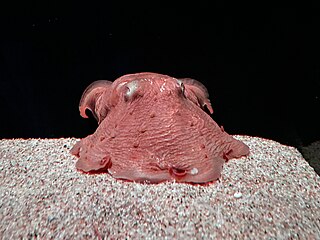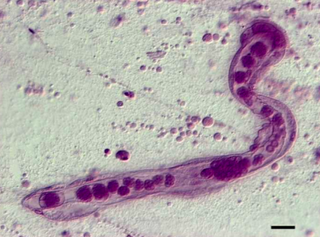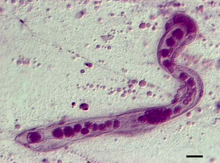
The Apicomplexa are organisms of a large phylum of mainly parasitic alveolates. Most possess a unique form of organelle structure that comprises a type of (non-photosynthetic) plastid called an apicoplast—with an apical complex membrane. The organelle's apical shape is an adaptation that the apicomplexan applies in penetrating a host cell.

The Mesozoa are minuscule, worm-like parasites of marine invertebrates. Generally, these tiny, elusive creatures consist of a somatoderm of ciliated cells surrounding one or more reproductive cells.

Trematoda is a class of flatworms known as flukes or trematodes. They are obligate internal parasites with a complex life cycle requiring at least two hosts. The intermediate host, in which asexual reproduction occurs, is usually a snail. The definitive host, where the flukes sexually reproduce, is a vertebrate. Infection by trematodes can cause disease in all five traditional vertebrate classes: mammals, birds, amphibians, reptiles, and fish.

Orthonectida is a small phylum of poorly known parasites of marine invertebrates that are among the simplest of multi-cellular organisms. Members of this phylum are known as orthonectids.

The Spiralia are a morphologically diverse clade of protostome animals, including within their number the molluscs, annelids, platyhelminths and other taxa. The term Spiralia is applied to those phyla that exhibit canonical spiral cleavage, a pattern of early development found in most members of the Lophotrochozoa.
Dicyema shimantoense is a parasitic worm of the phylum Dicyemida. It is a vermiform mesozoan parasite that infects the renal appendages of the cephalopod Octopus sasakii. The name is derived from the Shimanto River, which is the longest river in Shikoku, and flows into Tosa Bay. A study from 2000-06 used 59 specimens obtained from fishermen at Tosa Bay and Kii Strait in Japan. O. sasakii is a cephalopod found mainly in the shallow-water of Southern Japan. Research found that only those of certain sizes and geographical locations can be infected by D.shimantoense.

Amphioctopus fangsiao, called webfoot octopus, is a species of octopus, a cephalopod belonging to the genus Amphioctopus. It is found in the Pacific Ocean, including off the coasts of New Zealand as well as in the Yellow Sea and surrounding Chinese shores. It is also commercially fished.
Aggregata is a genus of parasitic alveolates belonging to the phylum Apicomplexa.

The Dicyemidae is a family of tiny parasites that live in the renal appendages of cephalopods. It contains the following genera and species:

Chromidina is a genus of apostome ciliates of the family Opalinopsidae. Species of Chromidina are parasitic in the renal and pancreatic appendages of cephalopods.

Chromidina elegans is a species of parasitic ciliates. It is a parasite of the cuttlefish Sepia elegans.

Chromidina elegans is a species of ciliates, described in 2016. It is parasitic in the kidney appendages of the cuttlefish Loligo vulgaris. The type-locality is off Tunisia in the Mediterranean Sea.
The Platytrochozoa are a proposed basal clade of spiralian animals as the sister group of the Gnathifera. The Platytrochozoa were divided into the Rouphozoa and the Lophotrochozoa. A more recent study suggests that the mesozoans also belong to this group of animals, as sister of the Rouphozoa.

Sepioloidea lineolata or more commonly known as the striped pyjama squid or the striped dumpling squid is a type of bottletail squid that inhabits the Indo-Pacific Oceans of Australia. Although traditionally falling within Sepiida, the cuttlefish order, it lacks a cuttlebone. More recent phylogenomic evidence suggests bottletail and bobtail squid may form their own order, Sepiolida. The striped pyjama squid lives on the seafloor and is both venomous and poisonous. When fully mature, a striped pyjama squid will only be about 7 to 8 centimetres in length. Baby striped pyjama squid can be smaller than 10 millimetres (0.39 in).

Opisthoteuthis depressa, also known as the Japanese flapjack octopus, is an octopus found in waters near Japan.
Kantharellidae is a family of worms belonging to the class Rhombozoa, order unassigned. The family consists of only one genus: KantharellaCzaker, 1994. The only species in the genus is Kantharella antarctica. This species is most closely related to other species of the order Dicyemida, which only has one other family, Dicyemidae.

Dicyema is a genus of worms belonging to the family Dicyemidae.

Dicyemennea is a genus of worms belonging to the family Dicyemidae.

Pleistoannelida is a group of annelid worms that comprises the vast majority of the diversity in phylum Annelida. Discovered through phylogenetic analyses, it is the largest clade of annelids, comprised by the last common ancestor of the highly diverse sister groups Errantia and Sedentaria and all the descendants of that ancestor. Most groups in the Clade find their ancestors within the Cambrian explosion when Annelid diversity expanded dramatically. The Pleistoannelida clade covers a variety of traits. However, the evolution of simple to complex eyes, developed papillae for burrowing, and for some specialized radioles for feeding can be seen universally across every species. New findings have discovered the range of Annelid diversity have led to uncertainty if groups with developed ancestral traits should remain within the clade. Furthermore There's been a lack of recently discovered Annelid traits being used in the categorization of groups within the clade, leading to many hypothesis on how to do so and which should remain within the clade. Currently three smaller clades that were originally a part of the groups Errantia and Sedentaria have been proven to fall outside while still being connected to the basal groups.
Dicyema clavatum is a species of rhombozoa within the family Dicyemidae. The species is known to parasitise Octopus minor as their hosts off Japan, along with Dicyema dolichocephalum and Dicyema sphyrocephalum, even being found alongside D. sphyrocephalum in O. minor individuals. Lengths of the species average at 1 millimeter.















